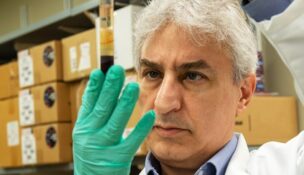The Roles of Manuka Honey, Silver in Animal Wellness, Wound Care
Glenn Polyn //November 1, 2022//
One of many approaches to treating wounds in companion animals is with natural products instead of antibiotics. For instance, animal wellness company W.F. Young, has made a name for itself from its line of natural Silver Honey wound care products. Pet Age recently spoke with Lucas Pantaleon, a Board Certified Internal Medicine Veterinarian with a special interest and expertise in infection prevention. Through his company, DVM One Health and Ogena Solutions, he advises clients in different sectors of animal health with the ultimate aim of improving health of animals, people and environment.
What is the skin microbiome, and how would you describe its role in healing?
The skin is the largest organ in the body, and it is colonized by millions of microorganisms (bacteria, fungi and viruses) that form the skin microbiota. These microbes have very important functions on the skin like protection against invading pathogens, breaking down natural products and “educating” the skin’s immune system. Many studies highlight the complexity of microbial skin communities in dogs, cats and humans.
The skin microbiome refers to how those microorganisms live in harmony with the pet on its skin. They live in a constant equilibrium state and are key players in health and disease conditions. In people and pets, improving the understanding of the skin microbiome is necessary to gain insight into microbial connection to skin illness and to develop new therapeutics.
When the skin barrier is broken down, the balance between “good and bad” microbes is altered, hence skin disease ensues. Several disorders of the skin are postulated to be caused, at least in part, by alteration in the skin microbiome such as atopic dermatitis (skin allergies), skin infections and lingering wounds. In humans and dogs skin allergy is a continuing, relapsing problem where the bacteria living on the skin change, opening the door for “bad” bacteria to grow and cause skin infections (hot spots). Healing of the skin barrier and re-establishing the equilibrium in the microbiome are key steps in the treatment of skin allergies and infections.
 What is medical-grade Manuka honey, and how does it help with wound care?
What is medical-grade Manuka honey, and how does it help with wound care?
Honey has been described as an ageless remedy for skin repair because its use dates back centuries. With the rise in antibiotic resistant bacteria, honey for the management of wounds and skin infection in humans and animals has stimulated new research, and it is more commonly used clinically.
Manuka honey (MH) is a mono-floral honey produced from the nectar of the Manuka tree. Manuka honey has several antibacterial compounds and healing properties which makes it an ideal treatment for wounds and skin infections in animals and people. It has many different compounds that act in synchrony to attack microbes at multiple sites, killing the microbes and making the appearance of resistance much less likely to develop.
Manuka honey has a high sugar content (approximately 80 percent), this dehydrates bacteria, killing the invading bacteria. Furthermore, MH is acidic (pH of 3.2 to 4.5), this being another factor that hinders the growth of microbes. It also has an enzyme able to transform sugar into hydrogen peroxide, which is an antiseptic. An additional advantage of MH compared to other honeys is the presence of a unique antibacterial compound called methylglyoxal (MGO). The amount of MGO is closely related to the antibacterial activity of MH. This non-peroxide antibacterial activity of MH is referred to as the unique Manuka factor (UMF). Studies have demonstrated that MH has antibacterial activity against bacteria like Staphylococcus aureus and Pseudomonas aeruginosa, which commonly cause skin infections in pets. Bacteria can coalesce in a resistant form called biofilm, which makes infections difficult to treat. Another important property of MH is that it can disrupt biofilm inactivating bacteria within it.
MH also contains antioxidants, flavonoids, phenolic acids and other enzymes, which are important determinants of its anti-inflammatory activity. Furthermore, MH aids with the formation of new blood vessels and the growth of cells that help with the healing of wounds.
How is silver beneficial to wound treatment?
Similar to honey, silver has been used for centuries for the treatment of different skin conditions. Silver ions have antibacterial effects, leading to bacterial damage and death. Antibiotics use a specific target to kill bacteria and bacteria can develop resistance by altering that target, rendering the antibiotic ineffective. Silver, as well as MH, uses a variety of mechanisms [targets] to kill bacteria and bacteria cannot cope with this attack and dies.
Additionally, silver has anti-inflammatory properties by increasing the formation of anti-inflammatory molecules within the wounds and other skin problems.
Silver products are often advocated for wound management, since silver ions have been shown to have microbicide effects. However, very high concentrations of silver ions applied directly to the skin –– such as with the traditional sliver products that come in the form of sprays, Silver Sulfadiazine and powders –– cause injury to the cells and interfere with the skin healing process. Newer silver formulations, like MicroSilver BG in Silver Honey, can release the silver ions in a more controlled manner preventing the toxic effect on the healing wound and providing sustained microbicidal activity.
What would you describe as an overlooked or underappreciated aspect of wound care?
Infection and inflammation are two key factors that affect wound healing. It is common for pet owners to use over-the-counter antibiotic creams when their pet has a skin infection (hot spot) or a wound. The overuse of antibiotics, including topical products, is a main driver for bacteria to become resistant to these vital compounds. Resistant bacterial infections are more difficult and costly to treat, leading to more suffering for the pet and greater expense to the owner.
The change from alternative products to antibiotics is becoming more common for veterinarians and consumers in order to prevent the emergence of resistant bacteria. Topical therapies such as Silver Honey are used to successfully treat skin infections and wounds, without causing the bacteria to become resistant and speed healing.
Another common issue with pet owners is that they use concentrated solutions of chlorhexidine, hydrogen peroxide and other antiseptics to clean wounds. These solutions are toxic to the growing cells of the skin, which impairs/slows down the healing process. Additional irritation caused by these solutions can cause pain to the pet and worsen the situation.
Studies have shown that MH and new silver formulations are very effective in treating bacterial infections on the skin with the advantage of not causing resistance. Furthermore, these natural products improve healing of skin without causing irritation or toxicity to the growing cells.
Pet owners, as well as veterinarians and human doctors, should do their part in preserving antibiotics for cases when they are absolutely needed. Using alternatives to antibiotics such as what we discussed here should be what pet owners should reach out for in the first place.



















